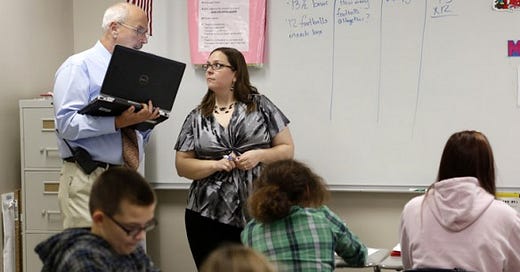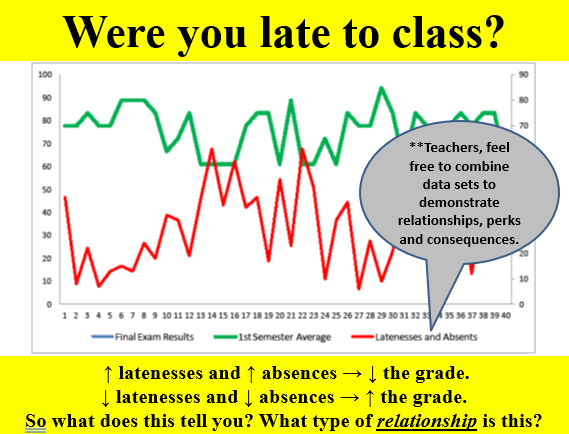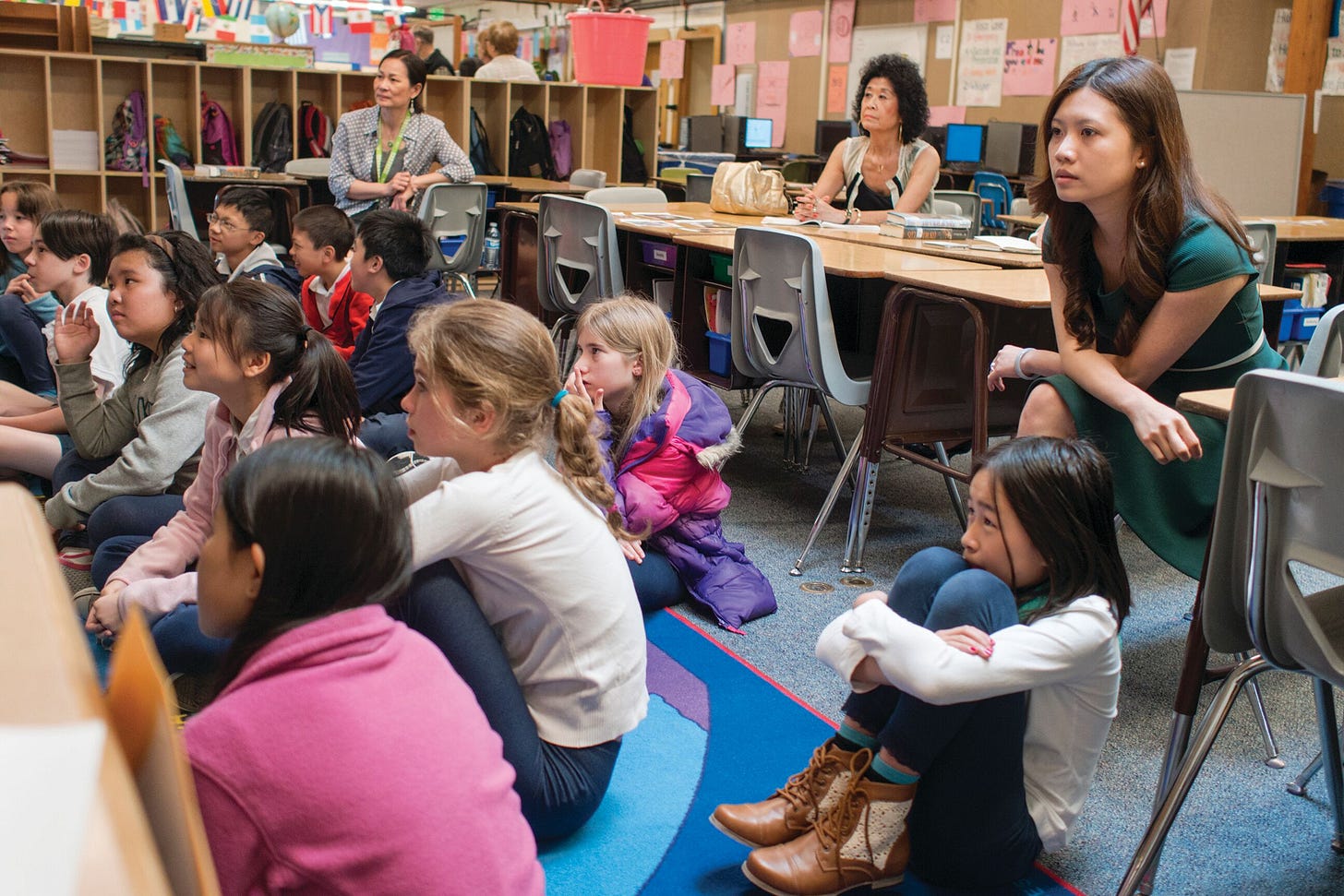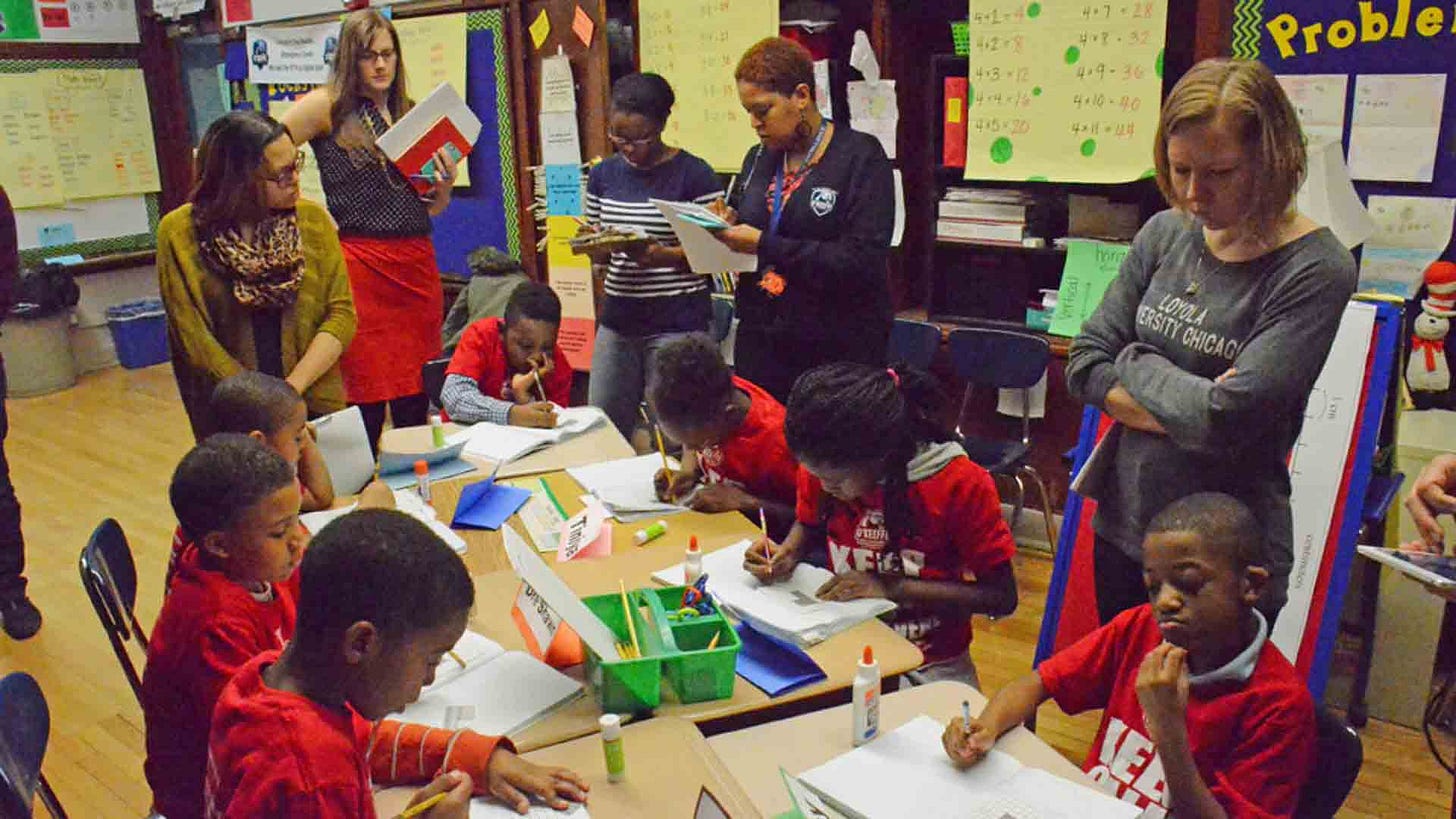A "Better" Teacher Observation - Part II
How to swap Goal-Setting + Data Analysis for Formal Observations. It can be done!
Why am I proposing an alternative system of observing teachers? The reason is simple:
The current system of teacher observation is not working. It fails to professionally develop teachers on any level.
Observations with this or not, are a “gotcha” game. “I want to see ‘this’ and if I don’t, then I gotcha.” Why else would so many administrators give a “heads up” as to what day they will be coming in on or what they will be looking for, or focusing on?
Administrators are not seeing the full extent of what teachers are doing on a daily basis in their classrooms. There is so much “good” happening in classes each and every day, but most never see it. I want admin to see these great things that are happening! In other words, admin should have “full disclosure” on a daily basis.
If teachers are “observed” for the same basic classroom fundamentals on a yearly basis, they will never be able to fully develop their “Professional Potential”.
To be honest, I don’t even like the word “observed”. I was watching Star Trek (yes, Voyager) the other day and Captain Janeway was walking through engineering, when everyone came to attention and the head engineer (obviously rattled) said, “I didn’t know we were having an inspection, Captain!” She replied, “You’re not. Let’s just call it taking a stroll.” That’s what we need… more strolls and less formal observations. Watch for next week’s post all about my favorite principal, Charlie, and his wonderful “strolls".
So, do administrators who are doing the observing, honestly believe that by year 3, or 16, or 31 that teachers (who write Aims, Goals and Do Nows on their boards every day) still need to have these very same essentials of daily teaching evaluated - often by the same person with the same results? And do they believe that classroom observations are really the best metric of overall competency? In other words, is the Goal or Aim of a teacher evaluation being achieved?
Observers, what are you thinking as you walk into the room of a teacher you have been observing for the past 10 years with similar results each time? Do you ever think, “I know this is a top shelf teacher - there must be a better way!” I have spoken one-on-one with administrators and supervisors and even they agree that a) they don’t see a great benefit given the necessary time and effort expended it takes to observe teachers and b) they really don’t like doing them. Together, we can change this.
What is the Goal of a Teacher Observation?
Simply put, administrators want to and need to know how teachers are doing. There is no assigning blame or fault - only a desire to improve a system that is currently failing students because it is failing the teachers (and even the administrators!)
3 Points according to the NYS Education Department:
“The primary purpose of the evaluation system is to provide useful information to administrators and educators that can support the continuous development of educators.” Pardon my bluntness, but what “useful information” can possibly be extracted from an observation that are at best staged (often described as a “dog and pony show”) and that the observer has likely seen this same teacher go through for years now. So what “new” useful information is being “discovered” to justify this year after year?
When implemented in a manner consistent with best practices, these measures are essential to improving teacher and principal practice. With the exception of tidbits (such as a former principal telling me how she found it better to teach the vocabulary after the first lesson it is used in - that was a great strategy!) can someone explain to me how each successive year of being “observed” improves a teacher’s “practice”?
Under the Education Law, the Observation/School Visit category for teachers and principals must be based on at least two types of required observations/school visits and may also include optional peer observations/visits. Well, how many of us have ever been offered to opportunity to formally “peer observe” our colleagues, whose classroom techniques and styles we know and would greatly benefit from learning more about? If given the opportunity, who would choose this option? This should be a MAJOR part of any alternative to current observations.
There are two basic types of observations:
A school administrator watches a teacher’s performance as a part of a formal job performance evaluation at a regularly scheduled interval (often several times during the school year). We are all very familiar with this.
An observation performed by a teacher’s peer or peers with the stated goal of providing the teacher with relevant feedback based on their interactions with students and their execution of teaching methods with the primary goal of making improvements in their classroom management and instructional techniques. These are often done by an instructional specialist or coach, but are similar to administrative observations and much less effective than true peer to peer evaluations where you are more likely to see a more natural classroom environment and receive more candid and honest feedback.
The process of evaluation should be a positive growth experience, but instead it ranks as the #1 most uncomfortable, unforgiving and nerve-wracking experience that teachers go through - multiple times every year for their entire career - no matter your level of seniority. You could be a 30+ year veteran educator and yet you are mandated to be observed most likely by administrators with fewer years in the classroom than yourself - every year without exception. How many years does an administrator need to watch a teacher differentiate a Do Now before that teacher is considered to be highly proficient or expert in their field as a science teacher, or an English teacher? And how does it affect a 25-year veteran’s sense of self worth (who has a stellar track record) to be told their “mini-lesson” needs to be shortened? How is this possibly helping? Education is the only field where this chronic oversight takes place in a profession that has the highest attrition rate of all other professions - while as of 2022, more teachers are pushing up their retirement date than ever before. We really need to rethink this part of schools.
It will take people who are willing to try something different from an administrative perspective, and trust me, this is not as easy as it sounds. Schools, where innovation and development should be at the forefront are slow and resistant to change unless it fits their paradigm, while the private sector is continually reinventing themselves so as to increase overall productivity and career stability. That being said, how many principals are genuinely willing to try an alternative to the traditional teacher observation? To a pilot class, or an entire school, the logistics are very much the same as they are for any other highly productive data-driven professional office.
There is an adage in business, “If you want to be successful, copy what successful people are doing.” Teachers live by that motto. I remember when I first heard Harry Wong say the way to be a great teacher is to “steal, steal, steal” ideas from your fellow educators! He is right! And this is how every profession outside of education increases their sense of professional proficiency. This is why principals must begin making Peer to Peer Observations a part of their schools if they are to develop top shelf teachers. Teachers crave seeing what others are doing. It is how we expand our repertoire. It is not enough to catch a glimpse into your colleague’s room, see something you like, and incorporate it into your own bag of tricks. We need to spend time in our neighbor’s rooms - both veteran and novice - to see what they are doing, what is working for them, and how we can make it work for us.
That is Part I of re-thinking the current process of “formal observations”. Part II is to have teachers begin to organize their data in such a way so that principals, AP’s and Supervisors have immediate - and instant - access to all classroom stats upon entering any classroom.
The School Goals Work program shows how to collect and present classroom data so that any administrator, at any time, can walk into your room, look at your Goal-Setting Board (below), opening up any Student Goal-Setting Folder and review your Teacher Data Binder to know a) how your students are doing and b) what you are doing to help them reach their goals and c) how you are doing.
One of the big problems facing students today is that they are not being taught how to set goals that will energize them, provide a means of directing their progress, force them to think outside their boxes and show them new methods and techniques for reaching their goals and achieving success! SMART goals will never accomplish this!
How many of you have collected and organized the necessary data to use PowerPoints to demonstrate to classes (both individually and collectively) how they are doing (e.g. - by comparing EGB log-ons to individual GPA’s)
or perhaps explaining how their arriving late to class not only distracts others, but lowers their grades? Lateness vs. GPA (Does this show a direct or inverse relationship? And what does it mean to students? Can you think of a better way to encourage on-time arrival?)
Or to show completed homework vs. student GPA’s
This is why schools must move away from the “shiny new penny” or the “low hanging fruit” concepts of advancing student achievement. Why? Because no matter how interesting or unique and idea may be this approach is not working. All too often, the safe route is the route most travelled: new apps, new smart boards, and more new apps. But this is not producing the change all of us are seeking! (Don’t schools read Robert Frost anymore?)
Times are getting worse and so now is the time to change how we increase student motivation and create a sense of urgency to succeed! Using the School Goals Work program, observations would consist of three parts:
Data Collection (based on Goal-Setting, Prioritization and Time Management)
Peer to Peer Observations - more will be gleaned from these than administrative observations any day of the week!
Informal Walk-Throughs - with teachers being shown a new and different way to organize classroom data, it is easy to make informal 5-minute walk-throughs positive learning experiences.
So to institute real change in schools, and teacher observations, those looking to take “the road less traveled” will need to have the following in place:
Effective Electronic Grade Book (EGB) Most schools already use these and most comes with all the bells and whistles, but you only need a handful of features to run a data-driven classroom, which is why I like JupiterEd. The EGB must also be able to produce quizzes, tests, worksheets, interactive assignments, etc… It not only saves time, but it allows for a daily up-to-date average for all to see - and use for goal setting!
Student Work – must be graded, entered and posted the same day it is received. By assigning all work via the EGB makes this simple. Same Day Grading is a non-negotiable. Why? Because you cannot keep accurate stats - or set goals - without timely data. Doing so also keeps parents on your side.
Student Goal Setting - the most important item any teacher can learn about student success! Students must set and monitor their class goals every week! My students loved doing this!
Professional Development - All teachers must be provided professional development with a comprehensive “Goal Setting, Data Collection and Statistical Analysis Program” (such as School Goals Work) for their classes that teaches specific strategies and procedures for collecting/recording all student/classroom data.
Data Collection by Teachers - Basic data such as grades for tests, quizzes, HW, and attendance are only rudimentary statistics and are obviously insufficient as little is currently being done beyond “posting” these grades and numbers. Statistical analysis and trending of class data plus additional unmined data (the secret sauce which I teach in School Goals Work) must be included. The data is kept in the classroom and must be available to all visitors. It must be updated daily. This information must be recorded on paper while this data is periodically represented in graph form to students usually via PowerPoint presentations.
Trending - is a basic tenet of this system. Students must be taught Goal Setting and Trending. Statistical Analysis of Data Trending (that every pro athlete uses daily) to increase their “sense of urgency” through Goal Setting, Time Management, Prioritization and to increase awareness of their progress. This is why I advocate for stopping SMART Goals today! They are a useless waste of time! It is the data collection and analysis by students that increases student engagement and reduces teacher/administration monitoring exponentially.
Pre-Observation - Currently, the only statistical data that administration has before a pre-observation are grades, but that is not enough. Administrators would be much better prepared to “consult” with teachers regarding progress, strategies, successes, etc… and could, in fact, eliminate pre-observations.
Peer to Peer Observations/Intervisitations – Much of the legwork regarding the evaluation of teachers could be eliminated via Peer to Peer Intervisitations. These are well-documented formal observations done by teachers. Documentation is developed by the teacher and made available to both administrator and observee. Each school has veteran teachers (experts!) who would jump at the chance to have colleagues/new teachers visit their class and observe how a smooth classroom works. I bet every principal could pick out at least 10 experts they would like to have new teachers observe and imagine how much these observers would learn! Imagine the encouragement and bolstering these veteran experts would experience. Or how about new teachers observing other new teachers? This is how a professional becomes self-actualized. Either we want a piece of paper (an observation) in the teacher’s file, or we want highly competent and highly-developed teachers. I would rank this right up there with using Goal Setting, Prioritization, Time Management & Scripting in each teachers’ repertoire.
Regular “high-visibility high-profile” walk-throughs - in combination with Peer to Peer Observations and in lieu of more formal observations. And by providing principals/AP’s access to student and classroom data this could be a reality. How many 5-minute “informal” walk-throughs (observations) could be accomplished in lieu of one formal? (i.e. - 90 teachers with 4 AP’s - would take each AP a maximum of 2 hours each/week, maximum of 1/2 hour/day to evaluate everyone every week! And even less if the principal jumped in to pick up any slack doing a “weekly stroll”!)
Data Drives Observations - Employers evaluate employee trending regularly in the private sector. There is less physical oversight followed by greater self-actualization and personal development. Trust increases thus job satisfaction increases. (Statistical analysis of data trending is the keystone of this program.) How would an AP know if a teacher is doing poorly? A 5-minute look over the teacher’s data will let him or her know. At that point, teachers can then be consulted regarding statistics to include peer-intervention for support and advice, reassessment of goals, strategizing what is working and what is not, all within a time-frame for improvement and possibly individual student input. This is using data smarter, not harder!
I get it. This is all new to many of you and at first glance, this looks complicated and sounds like more work than teachers and administrators currently do. It is actually less work, but a more effective way of determining how teachers and students are doing. In reality, using my system, I could have been observed 6x each year and the process would have taken less than 1 hour - total!
These are just the basic components of a proposal. Each school is different, but the School Goals Work program can be implemented at any location. And while some points may be a bit unorthodox for administrators who feel they absolutely must stick to a proscribed route of evaluation, remember that change is good. I developed the School Goals Work program of Data Collection, Statistical Analysis, Trending, Prioritization, Time Management, Scripting and true Goal Setting in my own classes and used it all the years I taught. Now, if we can only get a few principals to pilot this type of approach, we might start moving closer to the positive student change we seek.
Dr. Cubbin - School Goals Work
schoolgoalswork.com / schoolgoalswork@gmail.com / 631-664-7885











